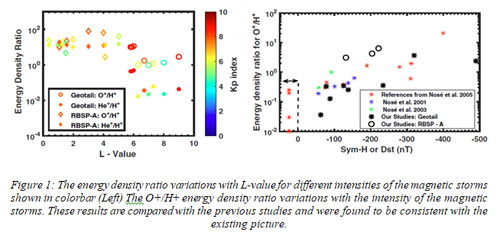 Researchers from the Indian Institute of Geomagnetism (IIG) an autonomous institute under the Department of Science & Technology (DST) have deciphered the mechanism in which charged particles behave in the earth’s inner magnetosphere, a factor that could be crucial in the design of more robust space systems and spacecrafts in the future.
Researchers from the Indian Institute of Geomagnetism (IIG) an autonomous institute under the Department of Science & Technology (DST) have deciphered the mechanism in which charged particles behave in the earth’s inner magnetosphere, a factor that could be crucial in the design of more robust space systems and spacecrafts in the future.
The team of scientists from IIG studied the complex interactions of the Earth’s magnetic field with the Sun’s Interplanetary Magnetic Field (IMF) and turbulent solar wind to understand the characteristics and dynamics of magnetospheric charged particle populations.
Dr. Megha Pandya in her doctoral research under Dr. B. Veenadhari unveiled multiple features of energetic electrons and ions trapped in the Earth’s inner magnetosphere by studying different dimensions of the ring current ( an important magnetospheric particle population) and Van Allen radiation belts (zone of energetic charged particles, most of which originate from the solar wind, that are captured by and held around by earth’s magnetic field) using data from multiple satellites. These radiation belts and the ring current are part of the chain that interconnects the Sun and interplanetary space with the terrestrial magnetosphere and ionosphere. The multi-point measurements from different satellites helped identify the underlying acceleration, loss, and transport mechanisms of the charged particles.
Earlier, understanding of the inner magnetospheric ions was restricted to single spacecraft observations and limited number of events. For large number of magnetic storms, the researchers used the Relativistic Electron Proton Telescope to compile a wide spectrum of electron characteristics in terms of energy, L-value, solar wind parameters, and phases of the magnetic storm. Currently, the causes and reasons behind processes that accelerate ions and electrons from benign energies to energies capable of damaging spacecraft is not fully understood.
 Dr. Megha’s work published in the journal ‘Earth, Planets and Space’ has unveiled the observational support to the mechanism how the inner magnetospheric plasma is replaced with the freshly injected plasma from the near-Earth plasma sheet. She has inferred heavier ions are likely to undergo a mass-dependent energization when they are transported from plasma sheet to the Earth’s inner magnetosphere. Her research work published in ‘Journal of Geophysical Research-Space Physics’ has also tried to decipher the physics behind the storm time electron flux variations like enhancements, depletions, or no change in terms of different solar wind sources, distance from the Earth and energies. The result suggests a delicate balance between the amount of acceleration and loss.
Dr. Megha’s work published in the journal ‘Earth, Planets and Space’ has unveiled the observational support to the mechanism how the inner magnetospheric plasma is replaced with the freshly injected plasma from the near-Earth plasma sheet. She has inferred heavier ions are likely to undergo a mass-dependent energization when they are transported from plasma sheet to the Earth’s inner magnetosphere. Her research work published in ‘Journal of Geophysical Research-Space Physics’ has also tried to decipher the physics behind the storm time electron flux variations like enhancements, depletions, or no change in terms of different solar wind sources, distance from the Earth and energies. The result suggests a delicate balance between the amount of acceleration and loss.
Through another research published in ‘Journal of Geophysical Research-Space Physics, ’ she has also explained the mechanism responsible for the electron pitch angle distribution (a type of distribution crucial to understand electron dynamics in the planetary magnetosphere)during different phases of the magnetic storm. According to her, it evolves during the storm main phase while during the storm recovery phase, the electron distributions are found to restore to their original configuration due to restoration of Earth’s magnetic field.
The streaming high-energy protons, electrons, and other heavier ions in the near-Earth space can interact with spacecraft in several damaging ways. The energetic electrons can penetrate through the thick spacecraft shielding and can upset spacecraft computer memories and disrupt sensitive space electronics. This results in damage to satellite solar power panels, optical tracker systems, spacecraft control systems, etc.
The near-Earth space environment is mainly disturbed by the Sun’s magnetic field variability and related violent solar eruptions. Thus the current research work by Dr. Megha will help to understand the set of possible interactions between the space environment and spacecraft, which affect unique, robust, and reliable space systems. To study the relativistic electrons with sufficiently high energy (which are extremely harmful for the sensitive sensors on the spacecraft), it is important to understand its behavior during different geomagnetic conditions. The knowledge of the electron and ion dynamics will play a major role while designing these sensors.
Publication links:
- Megha Pandya, BhaskaraVeenadhari, Masahito Nosé, Sandeep Kumar, Geoff D. Reeves, and A. T. Y. Lui, Characteristics of storm time ion composition in the near-Earth plasma sheet using Geotail and RBSP measurements, Earth, Planets, and Space, Vol. 70. Article No. 203, doi:10.1186/s40623-018-0977-3, December, 2018.
- Megha Pandya, BhaskaraVeenadhari, Yusuke Ebihara, Shrikanth G. Kanekal, and Daniel N. Baker, Variation of Radiation belt electron flux during CME and CIR driven geomagnetic storms: Van Allen Probes observations, Journal of Geophysical Research-Space Physics, Vol. 124, No. 8, pp. 6524-6540, doi:10.1029/2019JA026771, August, 2019.
- Megha Pandya, BhaskaraVeenadhari, Yusuke Ebihara, Shrikanth G. Kanekal, and Daniel N. Baker, Evolution of pitch angle distributed MeV electrons during each phase of the geomagnetic storm, Journal of Geophysical Research-Space Physics, Vol. 125, No. 1, e2019JA027086, doi:10.1029/2019JA027086, January 2020.
For more details Contact Dr. Megha Pandya (megha14[at]iigs[dot]iigm[dot]res[dot]in)






























